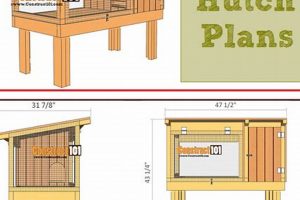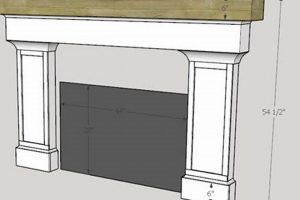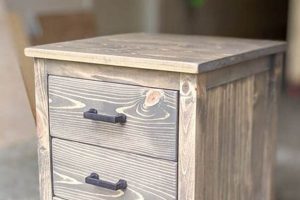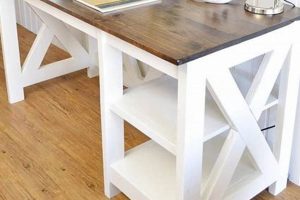Construction documents that provide detailed instructions for building a raised platform specifically designed to support a washing machine and a clothes dryer are widely available. These resources often include material lists, step-by-step assembly guidance, and dimensional diagrams intended for individuals undertaking a do-it-yourself project. For example, an individual might seek out these instructions to create a sturdy base that elevates their laundry appliances.
Elevating laundry appliances offers several advantages, including improved accessibility, reduced strain on the user’s back, and additional storage space beneath the appliances. Historically, such modifications were less common, but with increasing awareness of ergonomic principles and space optimization, these projects have gained popularity. The accessibility benefits are particularly important for older adults or individuals with mobility limitations. The additional storage resolves space constraints in smaller laundry rooms.
Detailed examinations of materials selection, construction techniques, safety considerations, and design variations are essential elements of comprehensive information on building such structures. Furthermore, understanding the load-bearing requirements and ensuring compliance with local building codes are critical aspects of a successful and safe construction endeavor.
Construction Guidance
The following suggestions offer guidance for a successful platform construction process, enhancing safety and functionality.
Tip 1: Material Selection: Prioritize moisture-resistant materials, such as pressure-treated lumber or marine-grade plywood, to prevent rot and structural degradation, particularly in environments prone to humidity. For example, a frame constructed from pressure-treated 4×4 lumber offers superior resistance to moisture compared to standard lumber.
Tip 2: Structural Integrity: Reinforce corners and joints with metal brackets or gussets to enhance stability and load-bearing capacity. Properly fastened and braced platforms are less prone to wobbling or collapse under the weight of appliances, minimizing the risk of damage or injury.
Tip 3: Precise Measurements: Before commencing construction, accurately measure the dimensions of both the washing machine and dryer, allowing adequate clearance for hoses, vents, and operational movements. Inaccurate measurements could lead to a platform that is too small or too large, complicating installation and potentially compromising functionality.
Tip 4: Leveling and Stability: Incorporate adjustable leveling feet to compensate for uneven flooring and ensure the platform is perfectly level. An unlevel platform can cause excessive vibration and noise during appliance operation, shortening the lifespan of the appliances and the platform itself.
Tip 5: Safety Precautions: During construction, wear appropriate personal protective equipment, including safety glasses, gloves, and hearing protection. Operating power tools without proper safety measures significantly increases the risk of injury.
Tip 6: Ventilation Considerations: Ensure adequate ventilation around the dryer vent to prevent the buildup of lint and moisture, which can pose a fire hazard. Proper ventilation is a crucial safety measure that can help prevent serious incidents.
Tip 7: Accessibility Planning: Incorporate design features that enhance accessibility, such as a shallow ramp for easier appliance loading and unloading, particularly for individuals with limited mobility. Prioritize an ergonomic design, particularly for the elderly or physically challenged.
Following these suggestions ensures a stable, safe, and functional appliance support system, leading to enhanced usability and longevity.
Subsequent sections address relevant building codes, aesthetic design choices, and long-term maintenance strategies related to platform construction.
1. Structural Integrity
Structural integrity forms the bedrock of any do-it-yourself appliance platform, directly influencing its safety, longevity, and capacity to adequately support heavy machinery. A robust structure prevents collapse, minimizes vibration, and ensures sustained performance over time.
- Load-Bearing Capacity
The platform must withstand the combined static and dynamic loads of the washer and dryer, which can be substantial, especially during spin cycles. Underestimation of load-bearing capacity can lead to structural failure, posing a safety hazard and potentially damaging the appliances. Selecting appropriate materials and construction methods directly dictates the load-bearing capability. For example, using a thicker gauge of lumber and reinforcing joints significantly increases capacity. A platform intended to support 300 pounds should undergo thorough testing to ensure it can safely accommodate the expected load with a margin of safety.
- Joint Stability
The strength and rigidity of joints are critical for maintaining structural integrity. Weak or improperly constructed joints are prone to loosening or failure under stress, leading to instability and potential collapse. Employing techniques such as mortise-and-tenon joints, reinforced with screws and adhesive, can significantly enhance joint stability compared to simple butt joints. Regular inspection and maintenance of joints are also essential to identify and address any signs of weakening or damage. Metal brackets and corner braces are highly recommended to mitigate these concerns.
- Material Degradation Resistance
The materials used in platform construction must resist degradation from moisture, temperature fluctuations, and potential chemical exposure (e.g., detergent spills). Degradation weakens the structure over time, compromising its ability to support the appliances safely. Using pressure-treated lumber or applying a protective sealant can mitigate the effects of moisture. Selecting materials resistant to chemical corrosion is also essential. Periodic inspections should assess the condition of materials for signs of rot, corrosion, or other forms of degradation.
- Vibration Dampening
Washing machines, in particular, generate significant vibrations during operation. An unstable platform can amplify these vibrations, leading to excessive noise, potential damage to the appliances, and even structural damage to the surrounding floor. Incorporating vibration-dampening materials, such as rubber pads or isolation mounts, can effectively mitigate these effects. Stiffening the frame and ensuring a level base further reduces vibration transmission. Over time, these vibrations can severely compromise structural connections, so active mitigation strategies are crucial.
Achieving structural integrity in a DIY appliance platform involves a holistic approach, considering load-bearing capacity, joint stability, material degradation resistance, and vibration dampening. Careful material selection, precise construction techniques, and ongoing maintenance are crucial for ensuring a safe, durable, and functional structure that can reliably support heavy laundry appliances for years to come. A failure in any of these areas significantly increases the risk of structural problems.
2. Material Selection
Material selection constitutes a critical phase in the execution of structures built for supporting laundry appliances. The choice of materials directly impacts the platform’s structural integrity, resistance to environmental factors, and overall longevity. Inadequate material selection can lead to premature failure, compromising the safety and functionality of the appliance support system. For example, the use of untreated lumber in a damp laundry environment invites rot and insect infestation, leading to structural weakening. Conversely, the selection of pressure-treated lumber or marine-grade plywood provides superior resistance to moisture, significantly extending the platform’s lifespan. Therefore, the choice of material is not merely an aesthetic consideration but a fundamental determinant of structural performance.
The load-bearing capacity of the selected materials is also paramount. Washing machines, particularly front-loading models, exert substantial weight and vibration forces during operation. Utilizing undersized or low-strength materials risks structural collapse or excessive flexing, potentially damaging both the platform and the appliances. Appropriate material selection dictates the use of lumber with sufficient thickness and density to withstand the anticipated loads. For instance, a frame constructed from 4×4 pressure-treated posts offers greater load-bearing capacity than one built from 2x4s. Reinforcing joints with metal brackets and employing high-quality fasteners further enhances structural stability, mitigating the risk of failure under heavy loads.
In summary, material selection significantly influences the success of any structural endeavor. The integration of appropriate materials mitigates safety hazards and amplifies the life-span of these applications. Therefore, careful consideration of material properties is paramount when embarking on constructing an elevated appliance platform.
3. Precise measurements
The creation of a stable and functional appliance platform hinges significantly on accurate dimensional specifications. Inaccurate measurements during the planning and construction phases directly compromise the platform’s fit, stability, and overall safety. Deviations from the intended dimensions can lead to appliances not fitting properly, creating instability, or preventing proper connections to water and ventilation systems. For example, if the platform’s width is underestimated, the appliances may overhang, creating a tipping hazard. Conversely, an overestimation of the width results in wasted space and aesthetic inconsistencies.
The process necessitates meticulous attention to detail. Initial measurements of the washing machine and dryer must account for all protrusions, including hoses, vents, and power cords. Furthermore, the dimensions of the available laundry space must be accurately assessed to ensure the platform integrates seamlessly without obstructing doorways or other essential elements. An example of proper procedure would involve using a laser measure to derive exact dimensions and double-checking with a traditional measuring tape to prevent reading errors. These measurements must then be transferred accurately to the cutting list for the platform’s components. Even slight discrepancies can compound during construction, leading to significant problems during final assembly.
The consequences of inaccurate measurements extend beyond mere inconvenience. A poorly fitted platform can induce excessive vibration, accelerate wear and tear on the appliances, and even pose a safety risk to users. Therefore, precise dimensional specifications represent a foundational element of a successful and safe construction endeavor, demanding rigorous attention to detail throughout the planning and execution phases. Accuracy here is not just a matter of aesthetics, but of safety and functionality, ensuring the completed structure is both stable and suitable for its intended purpose.
4. Safety compliance
The intersection of safety compliance and do-it-yourself appliance platform construction necessitates rigorous adherence to established codes and guidelines. Non-compliance poses significant risks, including structural failure, fire hazards, and electrical shocks. Platforms that fail to meet safety standards can jeopardize both the appliances and the surrounding environment, potentially resulting in property damage or personal injury. For example, improperly grounded electrical connections on a dryer installed on a self-made platform can create a shock hazard. Similarly, a platform constructed from flammable materials placed near a gas dryer vent increases the risk of fire.
Ensuring safety compliance requires a thorough understanding of local building codes, electrical regulations, and gas-fitting standards. These codes often dictate specific requirements for platform construction, including material specifications, load-bearing capacities, and ventilation provisions. Moreover, appliance manufacturers typically provide installation guidelines that address safety concerns. For instance, a common requirement mandates adequate clearance around the dryer vent to prevent lint buildup and overheating. Before commencing construction, homeowners should consult with local building officials and licensed contractors to ascertain all applicable safety requirements and to secure any necessary permits. Failing to secure proper permits can lead to fines, required modifications, or even the dismantling of the structure.
Effective safety compliance in do-it-yourself appliance platforms demands a proactive approach. Homeowners must prioritize safety throughout the entire construction process, from the initial planning stages to final inspection. This entails meticulous attention to detail, adherence to best practices, and a willingness to seek professional guidance when needed. In conclusion, neglecting safety compliance compromises not only the integrity of the platform but also the safety and well-being of the occupants, underscoring the imperative for rigorous adherence to established codes and regulations. The long term stability of both the platform and the appliances is at stake with unsafe execution.
5. Accessibility concerns
Construction projects involving elevated appliance platforms directly influence the usability of laundry facilities, particularly for individuals with mobility limitations or physical disabilities. The design and execution of such structures must, therefore, account for accessibility to ensure equitable and safe access for all users.
- Reduced Bending and Reaching
Elevated platforms minimize the need to bend or stoop when loading and unloading laundry appliances. This feature is particularly beneficial for individuals with back pain, arthritis, or other conditions that limit range of motion. For example, raising the appliance by 12-18 inches can significantly reduce the strain on the lower back, making the task of laundry more manageable and less physically demanding. A typical platform height of 15 inches has been found to significantly mitigate lower back stress.
- Wheelchair Accessibility
Platform design must consider the needs of wheelchair users. Adequate clearance in front of the appliances, typically a minimum of 30 inches by 48 inches, allows for comfortable maneuverability. In some cases, incorporating a knee space beneath the platform can further enhance accessibility. These design considerations enable wheelchair users to independently operate the appliances without requiring assistance. Designing for variable approach such as side approach will cover more population.
- Control Panel Height
The height of the appliance control panels must be within accessible reach ranges, typically between 15 and 48 inches above the floor. Positioning the platform so the controls are easily accessible ensures that users can operate the appliances without straining or stretching. If the control panels are too high or too low, individuals with limited reach may encounter difficulties, requiring assistance from others.
- Transfer Considerations
For individuals who transfer from a wheelchair to a seated position, the platform’s design should facilitate safe and easy transfers. Adequate space adjacent to the appliances, along with a stable surface, promotes independent transfers. Avoid sharp edges or obstructions that could impede transfer maneuvers. Designing such that a transfer bench can be implemented in the laundry area should be given high priority.
The integration of accessibility considerations into appliance platform projects is not merely a matter of compliance but a commitment to inclusivity and user-centered design. Thoughtful planning and execution ensure that laundry facilities are usable and safe for all individuals, regardless of their physical abilities. Prioritizing such considerations translates into enhanced independence, reduced risk of injury, and improved overall quality of life.
Frequently Asked Questions
The following addresses common inquiries regarding the planning, construction, and safety aspects of elevated appliance platforms. These answers aim to provide clarity and guidance for those undertaking such projects.
Question 1: Is obtaining a permit necessary before constructing an appliance platform?
Local building codes dictate permit requirements, which vary by jurisdiction. It is incumbent upon the homeowner to ascertain whether a permit is required for the construction of an elevated platform. Failure to obtain necessary permits can result in fines and mandated removal of the structure. Consult with local building officials to determine applicable regulations.
Question 2: What materials are best suited for constructing an appliance platform in a humid environment?
Pressure-treated lumber and marine-grade plywood exhibit superior resistance to moisture and decay, making them ideal choices for humid environments. These materials prevent rot and structural degradation, extending the lifespan of the platform. The application of a sealant can further enhance moisture resistance.
Question 3: How can vibration be minimized in an elevated appliance platform?
Vibration can be mitigated through several design and construction techniques. Incorporating vibration-dampening materials, such as rubber pads or isolation mounts, reduces the transmission of vibrations. Stiffening the frame and ensuring a perfectly level base also contributes to vibration reduction. Securing appliances to the platform is paramount for dampening vibration.
Question 4: What is the recommended height for an elevated appliance platform?
The optimal platform height depends on individual user needs and preferences. However, a height of 12 to 18 inches is commonly recommended, as it reduces the need for bending and stooping. Consider the height of the control panels to ensure they remain within accessible reach ranges. This height has been shown to alleviate strain on the lower back.
Question 5: What safety precautions should be observed during platform construction?
Wearing appropriate personal protective equipment, including safety glasses, gloves, and hearing protection, is essential during construction. Operate power tools with caution and adhere to manufacturer’s instructions. Ensure adequate ventilation to prevent the buildup of dust and fumes. Further caution is advised when working with electrical components.
Question 6: How can accessibility be incorporated into the design of an appliance platform?
Accessibility can be enhanced by providing adequate clearance around the appliances for wheelchair maneuverability. Consider incorporating a knee space beneath the platform and ensuring that control panels are within accessible reach ranges. Smooth ramps allow appliances to easily be rolled into place on the platform.
Proper planning and construction will result in a robust, safe, and functional platform that supports the appliances and improves the user experience. Consult professional resources when needed.
The following examines long-term maintenance procedures.
Conclusion
The preceding discussion detailed critical aspects of diy washer and dryer pedestal plans, ranging from material selection and structural integrity to safety compliance and accessibility. Each facet demands meticulous attention to ensure a functional and safe structure, capable of supporting heavy appliances while mitigating potential risks. These platforms provide accessibility advantages and increased storage within the laundry area.
Therefore, responsible project execution dictates thorough planning, adherence to building codes, and a commitment to safety protocols. The integration of ergonomic principles into the design phase guarantees usability for diverse populations. Diligence in these endeavors promotes the creation of a long-lasting and beneficial home improvement. Careful consideration prior to construction is paramount to a satisfactory outcome.







